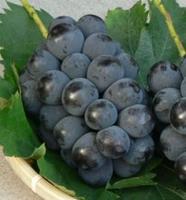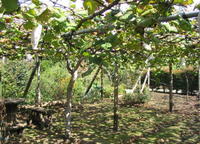:::::::::::::::::::::::::::::::::::::::::::::::::::::::::::::::::::::::::::::::::::::::::::::::::::::
Grebe (Podiceps family of Birds)
***** Location: South Central Alaska
***** Season: All Summer in Alaska, Winter in Japan
***** Category: Animal
*****************************
Explanation
Grebe (Podiceps family of Birds)
kaitsuburi, nio カイツブリ ニオ
A migratory water bird which lives in Alaska from May to late September.
Red-necked Grebe
Podiceps grisegena
Description
18-20" (46-51 cm). A slender bird and, in the East, the largest regularly occurring grebe. In breeding plumage, has rufous neck, black cap, whitish cheeks, and long, pointed yellowish bill. In winter, mainly gray, with paler cheeks, pale (not necessarily yellow) bill. In flight, distinguished from loons by its smaller size and white wing patches.
Habitat
Ponds and lakes in summer; large lakes, coastal bays, and estuaries in winter and migration.
Nesting
4 or 5 bluish-white eggs, stained brown, on a floating mass of dead reeds and grass in reedy lakes. Rarely nests in colonies.
Range
Breeds from Alaska and northern Canada south to Oregon, Idaho, Ontario, and southern Minnesota; rarely east to southern Quebec. Winters south along coasts to southern California and Georgia, rarely to Florida. Also in Eurasia.
Voice
Usually silent. On breeding grounds, a variety of squeaks, growls, and wailing calls.
Discussion
Highly aquatic, grebes can swim with only their heads above water, concealing themselves in low pond vegetation. The young, handsomely striped in black and white, are often seen riding on the parents' backs. Like loons, grebes are expert divers, propelling themselves with their lobed toes as they pursue fish, crustaceans, and aquatic insects.
http://www.enature.com/fieldguide/showSpeciesIMG.asp?imageID=17006

Click on the photo to see more !
:::::::::::::::::::::::::::::::::::::::::::::::::::::::::::::::::::::::::::::::::::::::::::::::::::::
The Pied-billed Grebe
Podilymbus podiceps
is a species of the grebe family of water birds. Since the Atitlán Grebe, Podilymbus gigas, has become extinct, it is the sole extant member of the genus Podilymbus.
The Pied-billed Grebe breeds in south-central Canada, throughout the United States, Central America, the Caribbean, and temperate South America.
Pied-billed Grebes feed mainly on aquatic invertebrates, and also on small fish and amphibians (frogs, tadpoles). Pied-billed Grebes have been shown to eat their own feathers to aid in digestion (prevent injury from small bones).
© More in the WIKIPEDIA !
*****************************
Worldwide use
The grebes are an ancient family going back 80 million years, well-represented in the fossil record, and not closely related to any other birds. They are adapted for diving, with legs set well back on the body and toes lobed. They spend virtually all their time in the water and are very ungainly on land, even when just turning eggs at an anchored nest of floating vegetation. The highly migratory northern hemisphere species, like the Horned Grebe, are brightly feathered in summer but become plain dark-and-white in winter. More sedentary birds, such as the Pied-billed Grebe, wear more similar plumages throughout the year.
Tropical grebes tend to be small and dark, from the Australasian Little Grebe of Australia & New Guinea to the Least Grebe of the American neotropics.
For pictures see this LINK.
http://www.montereybay.com/creagrus/grebes.html
xxxxxxxxxxxxxxxxxxxxxxxxxxxxxxxx
Japan
Kaitsuburi かいつぶり (or the reading of nio to make it shorter for counting 5-7-5) is a
kigo for winter.
Nio no su, the floating nest of the grebe at Lake Biwa and other lakes, is seen in spring (May), as in the following haiku by Basho. They are found so often and in great numbers, so the Lake is called “Nio no umi”, “Sea of the Grebe”.
1687年(貞享4年)の夏、芭蕉は江戸にあって二度目の長旅を計画していた。再び関西をめぐる「笈の小文」の旅である。こころは既に近江にあった。琵琶湖の葦の根本に作る鳰(にお)の巣でも見に行ってみようかと、友に旅の計画を打ち明けた。鳰はカイツブリのことで琵琶湖に多く棲息する。よって琵琶湖のことを「鳰の海」という。葦と鳰をみるには近江八幡の水郷がよい。
五月雨に 鳰の浮巣を 見にゆかん
samidare ni nio no ukisu o mi ni yukan
in the rain of the fifth month
let us go and see
the nest of the grebe
(Tr. Gabi Greve)
Matsuo Basho
(This is the fifth lunar month, now June, the rainy season in Japan.)

四方より 花吹き入れて におの海
shihoo yori hana fuki-irete nio no umi
Basho
from all directions
cherry petals blown in
the Sea of the Grebe
(Tr. Gabi Greve)
http://www.takase.com/Haiku/HaikuSource01.htm
Genju-An no ki (The Hut of the Phantom Dwelling)
by Matsuo Basho
I too gave up city life some ten years ago, and now I'm approaching fifty. I'm like a bagworm that's lost its bag, a snail without its shell. I've tanned my face in the hot sun of Kisakata in Ou, and bruised my heels on the rough beaches of the northern sea, where tall dunes make walking so hard. And now this year here I am drifting by the waves of Lake Biwa.
The grebe attaches its floating nest to a single strand of reed, counting on the reed to keep it from washing away in the current. With a similar thought, I mended the thatch on the eaves of the hut, patched up the gaps in the fence, and at the beginning of the fourth month, the first month of summer, moved in for what I thought would be no more than a brief stay. Now, though, I'm beginning to wonder if I'll ever want to leave.
http://terebess.hu/english/haiku/basho1.html
Matsuo Basho -
. - Oomi 近江 89 poems written in Omi, Shiga - .
*****************************
Things found on the way
*****************************
HAIKU
. WKD : Kobayashi Issa 小林一茶 in Edo .
水鳥よ今のうき世に寝ぼけるな
mizudori yo ima no ukiyo ni nebokeru na
mizu-tori yo
hey water birds,
in today's floating world
you've gotta stay wide awake!
Tr. Chris Drake
This humorous winter hokku was written in the 12th month (January) of 1815, when Issa had returned to Edo from his hometown for a visit. In it Issa refers to two meanings of "floating world": 1) the world of the migrating ducks, geese, and other water birds who spend the winter floating on the ponds, lakes, rivers, and bays of Japan, and 2) "today's" floating world (ukiyo 浮世), the material world of economic concerns and momentary but precious pleasures, entertainments, and interests.
The big city of Edo, where Issa is staying now, is the center of "today's" life- and pleasure-affirming floating world, whose culture can still be seen as portrayed in many woodblock color prints -- known as ukiyo-e, "floating world pictures" -- of various aspects of worldly commoner life. The word "today's" contrasts this commoner-centered, change-affirming floating world (ukiyo) with the traditional Buddhist view of the world as a place of transience and sorrow (also ukiyo, but one of the characters is different) that was predominant in the medieval period. Issa's True Pure Land school of Buddhism is also more affirmative of the material floating world than many of the older schools of Buddhism, and Issa does not seem to be denying this contemporary world and asserting the superiority of the older medieval belief that the world is full of change and sorrow. At the same time, Issa was critical of many aspects of contemporary life in Edo.
The hokku is in the form of direct address to the water birds, so Issa is probably near one of the many ponds, canals, or rivers running through Edo that generally didn't freeze over in winter. Since the birds have flown south for the winter, Issa may assume they are naive and don't know much about "today's floating world" in Edo very well. As a former country boy who came to Edo and gradually learned about life there the hard way, Issa seems to want to give them some helpful advice. The birds are apparently napping or drowsy when Issa sees them, so he tells them to wake up. If they don't keep their eyes wide open, there are all sorts of people in the contemporary floating world who are just waiting to con and deceive them into buying all sorts of nice things and engaging in all sorts of interesting but expensive activities.
In Edo the word 'duck' also referred to humans and meant 'sucker, chump, pushover,' and Issa's warning is obviously aimed at more than the wintering birds only. Still, though Issa is talking mainly to human readers, he no doubt tries to wake up the water birds as well, since, although hunting was forbidden to commoners in Edo, duck and goose meat were considered a delicacy if you could get them.
Chris Drake
Matsuo Basho and
. - ukiyo 浮世 floating world - .
:::::::::::::::::::::::::::::::::::::::::::::::::::::::::::::::::::::::::::::::::::::::::::::::::::::::
the upturned edges
of lily pads –
grebe calls
Cindy Zackowitz
(unpublished)
a shadow drifts
across the pond-
the grebe's tucked head
Cindy Zackowitz
http://haiku.cc.ehime-u.ac.jp/~shiki/shiki.archive/html/9805/0211.html
autumn sky -
the grebe rises
from it's wakeall
Cindy Zackowitz
http://home.gci.net/~alaskahaiku/saijiki.html
xxxxxxxxxxxxxxxxxxxxxxxxxxxxx
flying through snow
a grebe's calling
moonlit voice
Anna Holley
http://www.ahapoetry.com/wtcrowbk.htm
:::::::::::::::::::::::::::::::::::::::::::::::::::::::::::::::::::::::::::::::::::::::::::::::::::
In the next haiku we are back in Japan,
where the grebe is a kigo for winter.
the little grebe..
disappears.. .. .. .. .gone..
into the year end sea...
Basho
http://www.villarana.freeserve.co.uk/zipschool/haiku%20translation%20one.htm
*****************************
Related words
***** Loon birds (Gavia family)
***** Water birds, mizudori (#mizutori) 水鳥
:::::::::::::::::::::::::::::::::::::::::::::::::::::::::::::::::::::::::::::::::::::::::::::::::::::
[ . BACK to DARUMA MUSEUM TOP . ]
[ . BACK to WORLDKIGO . TOP . ]
:::::::::::::::::::::::::::::::::::::::::::::::::::::::::::::::::::::::::::::::::::::::::::::::::::::






















